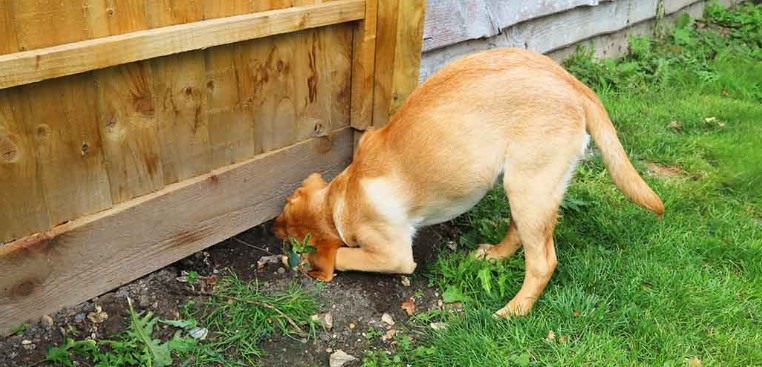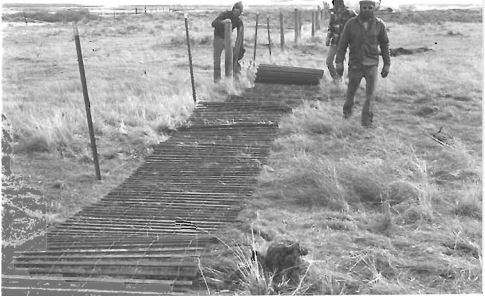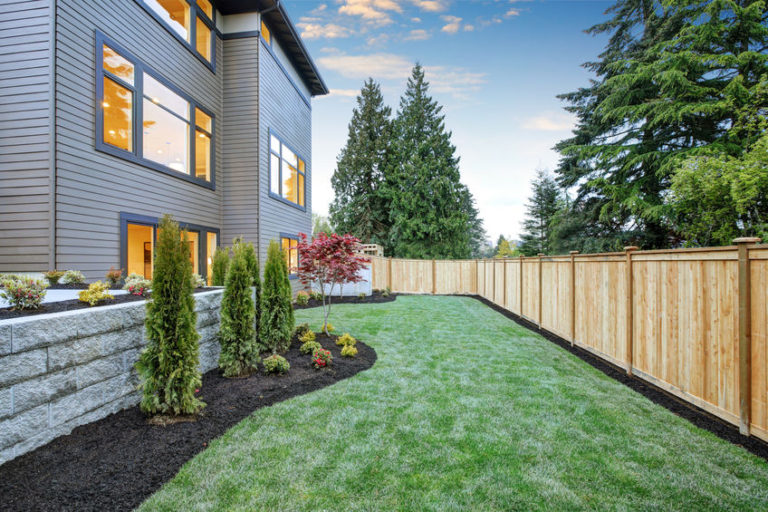
Dogs are curious and playful creatures that love to explore their surroundings. This can become a problem when they start digging under the fence in your backyard. Not only does it ruin your landscaping efforts, but it also poses a safety risk for your dog as they can escape and potentially get hurt or lost.
As Monmouth and Ocean County’s residential and commercial fence installation experts, our customers have shared plenty of ways they were able to successfully stop their dogs from digging under the fence without resorting to extreme measures like using shock collars or electric fences. Here are some effective methods you can use to prevent your furry friend from engaging in this destructive behavior.
Understanding Why Dogs Dig
Before we figure out how to stop your dog from digging under the fence, it’s important to understand why they do it in the first place. Dogs are natural diggers and have been doing so for centuries. Stray and wild dogs instinctually dig. Before domestication, canines used digging as a way to hunt prey, create shelter, or hide food.
Domesticated dogs may dig under fences for different reasons. Boredom, separation anxiety, or a desire to escape are some of the common motivations behind this behavior. Some breeds, such as terriers and dachshunds, are also more prone to digging due to instincts that have been strengthened through selective breeding.
Identify the root cause of your dog’s digging before implementing any solutions. If it’s due to boredom or lack of exercise, increasing their physical and mental stimulation can help reduce the behavior. If separation anxiety is the problem, working on desensitization techniques or seeking professional help may be necessary.
Plus, understanding why your dog is digging can also give you insights into potential solutions. For example, if they are doing it to escape, reinforcing the fence with materials that prevent digging may be more effective than trying to redirect their behavior.
Methods To Stop Your Dog From Digging
There are various methods you can use to prevent your dog from digging under the fence. Here are some of the most effective ones:
Provide Enough Exercise and Mental Stimulation
As mentioned earlier, boredom and lack of exercise are common reasons for dogs to engage in destructive behaviors like digging. Make sure your dog is getting enough physical activity and mental stimulation throughout the day. This can include walks, playtime, training sessions, puzzle toys, and more.
Engaging in these activities with your dog not only keeps them physically fit but also strengthens your bond and can prevent boredom-related behaviors. Consider creating a schedule for your dog’s daily routine to provide structure and predictability. This can help alleviate any anxiety or restlessness they may be feeling.
Bury Chicken Wire Along the Fence Line
If your dog is a persistent digger, you may need to use fortify a physical barrier to prevent them from escaping under the fence. One of the most commonly recommended method is to bury chicken wire along the perimeter of the fence line.
First, dig a shallow trench about one foot deep around the fence line, making sure it’s flush against the bottom of the fence. Then, lay the chicken wire in the trench and cover it back up with soil. This effective strategy will create a barrier that is difficult for dogs to dig through.

Does burying chicken wire stop dogs from digging?
While this method may be effective for some dogs, it’s not a foolproof solution and may have its drawbacks. One disadvantage is that it may harm your dog if they accidentally come into contact with the wire while digging. It’s important to use sturdy and rust-resistant wire, as well as bury it deep enough to prevent any sharp edges from being exposed.
Burying chicken wire may not address the root cause of the digging behavior. Dogs often dig out of boredom, anxiety, or in search of a cool spot to lie down. It’s important to identify and address these underlying issues to prevent your dog from finding other ways to escape or engage in destructive behavior.
Use Citrus or Spicy Scents to Deter Your Dog
Dogs have a strong sense of smell and are often deterred by certain scents. Using citrus or spicy scents around the fence line can discourage your dog from digging under it.
You can use natural remedies like citrus peels, cayenne pepper, or essential oils such as lemon or peppermint. Simply sprinkle or rub these scents along the bottom of the fence and repeat regularly to maintain their effectiveness. While this method may not work for all dogs, it’s worth trying as a non-invasive and safe option.
Plus, it can also have additional benefits like keeping pests away from your fence line. Additionally, it’s important to note that these scents may also bother your neighbors or other pets in the area.
Implement Positive Reinforcement Training Techniques
Positive reinforcement training can be effective in redirecting your dog’s behavior. This involves rewarding them for desirable behaviors and ignoring or redirecting undesirable ones. Don’t punish your dog for digging or any other behavior. This can cause fear and aggression in your dog and may make the problem worse.
For example, you can teach your dog to “leave it” when they start digging under the fence. Every time they comply, reward them with a treat or praise. Over time, they will learn that digging under the fence is not desirable and will stop. It’s important to remain consistent and patient while using positive reinforcement training techniques. It may take time for your dog to understand and change their behavior.

Seek Professional Help for Underlying Behavioral Issues
Seek professional help if your dog’s digging behavior is due to underlying behavioral issues. A certified professional trainer or animal behaviorist can assess your dog and develop a personalized plan to address any underlying issues that may be causing them to dig under the fence.
If your dog has anxiety, struggles with boredom, or has obsessive or territorial behaviors, professional dog trainer or animal behaviorist can help. It may involve a combination of training techniques, behavior modification, and possibly medication in severe cases.
With proper guidance and treatment, you can address any underlying behavioral issues and help your dog overcome their destructive digging behavior. Remember to remain patient and consistent, and always keep your dog’s safety and well-being as the top priority.
What could I put in front of the fence to keep the dogs from digging under and make it look nice?
There are a few options for adding a barrier in front of your fence to prevent dogs from digging under, while also maintaining a visually pleasing appearance. Here are a few ideas:
Dig Defense panels
Dig Defense panels are specially designed panels that attach to the bottom of your fence, making it difficult for dogs to dig under. These panels come in various sizes and are made from galvanized steel, and can easily be installed along the entire perimeter of your fence.
A benefit of using Dig Defense panels is that they are discreet and don’t change the look of your fence. They are also durable and long-lasting, making them a cost-effective solution in the long run. These panels may not be suitable for all installation situations and may require some digging or modification to install.
Products similar to Dig Defense are easy to find online and you can get them in different lengths and heights to best suit your situation. This Animal Barrier Fence, available from Amazon, is installed in front of your existing fence creating another layer of protection to make it more difficult for animals to dig under or around it. This additional obstacle layer will reduce the reward or anticipation of being almost to the other side for digging dog and they will be more likely to lose interest in the previously entertaining escape route. Once the habit is broken and the appeal is gone, you may even be able to remove them eventually as your dog’s attention will be focused on other activities in the yard.
Raised garden beds or flower boxes
Raised garden beds or flower boxes can serve a dual purpose of adding beauty to your backyard while also deterring your dog from digging under the fence. These can be easily installed along the fence line, and you can choose from a variety of sizes, styles, and plants to fit your specific needs.
One advantage of using raised garden beds or flower boxes is that they act as a physical barrier that makes it difficult for dogs to dig under. Plus, depending on the type of plants you choose, they can also add a pleasant scent to your backyard. However, keep in mind that these may require some maintenance and upkeep, especially if your dog is prone to digging or chewing on plants. It’s best to choose sturdy and non-toxic plants for this purpose.
Plus, if you have a larger or more active dog, they may still be able to jump over or maneuver around the garden beds. In this case, it’s best to reinforce the garden beds with additional barriers such as chicken wire or paver stones.
Decorative rocks or stones
Decorative rocks or stones are another option for adding a barrier in front of your fence while maintaining an attractive aesthetic. These can be placed along the bottom of your fence, creating a physical barrier that is difficult for dogs to dig through.
One advantage of using decorative rocks or stones is that they come in various shapes, sizes, and colors, allowing you to customize the look of your backyard. They are also durable and low-maintenance, making them a long-term solution for preventing digging.
Additionally, it’s important to choose rocks or stones that are large enough to prevent your dog from moving them or digging under. You can also use a layer of landscaping fabric underneath to prevent weeds from growing through the rocks.
So with these options in mind, you can choose the best solution for your specific situation and keep your dog from digging under the fence while also enhancing the appearance of your backyard. Always prioritize your dog’s safety and well-being, and seek professional help if needed for any underlying behavioral issues.
Mistakes that may make your dog continue to dig under the fence
While there are various solutions for preventing dogs from digging under fences, it’s also important to avoid certain mistakes that may actually encourage or reinforce this behavior. Here are some common mistakes that dog owners make:
- Not providing enough physical and mental stimulation: Dogs need regular exercise and mental stimulation to keep them from getting bored and engaging in destructive behaviors such as digging. If your dog is not getting enough physical activity and mental enrichment, they may turn to digging as a form of entertainment.
- Not addressing underlying behavioral issues: As mentioned before, dogs often dig out of boredom or anxiety. It’s important to identify the root cause of your dog’s digging behavior and address it through positive reinforcement training or seeking professional help.
- Inconsistent reinforcement: If you’re using a physical barrier such as chicken wire or rocks to prevent your dog from digging, it’s important to be consistent with its use. If the barrier is not in place consistently, your dog will learn that they can still dig under the fence when it’s not there.
- Punishing or scolding your dog: Punishing or scolding your dog for digging may actually reinforce this behavior. Dogs may see attention, even if negative, as a reward and continue to dig in order to get that attention from their owner.
- Not providing an alternative outlet for digging: Instead of trying to completely stop your dog from digging, provide them with a designated area where they are allowed to dig, such as a sandbox or digging pit. This can help redirect their behavior and prevent them from finding other areas in your yard to dig.
By avoiding these mistakes and implementing the appropriate solutions, you can effectively prevent your dog from digging under the fence and keep them safe in your backyard. Remember to always prioritize their well-being and address any underlying behavioral issues for long-term success.
Preventing your dog from digging under the fence requires a combination of methods and considerations
It’s important to prioritize their safety and well-being while also addressing any underlying behavioral issues. With patience, consistency, and proper solutions, you can successfully keep your dog from escaping your yard and enhance the overall appearance of your backyard.
Remember to always seek professional help if needed for any persistent or underlying behavioral issues. By following these tips and being proactive in addressing your dog’s digging behavior, you can create a safe and happy environment for both your pet and yourself. So, rather than resorting to extreme measures like electric fences or punishments, consider using a combination of methods and providing appropriate outlets for your dog’s natural instincts.
Want A New Fence Quote in New Jersey? Contact Us Now or Call 732-905-0006
FAQs
Should I use a combination of methods to prevent my dog from digging under the fence?
It may be beneficial to use a combination of methods such as burying chicken wire and adding decorative rocks or plants to create a stronger barrier. This can also help address multiple underlying causes for your dog’s digging behavior.
Can training alone stop my dog from digging under the fence?
Training can be a helpful tool in preventing your dog from digging under the fence, but it may not be enough on its own. When relying on training, management and attention is an important factor. Do not leave your pet alone in the yard and expect them to follow a command you gave 15 minutes ago with no reward available to work for. As responsible dog trainers, we have to have reasonable expectations for our animals and for the process. It’s important to also address any underlying behavioral issues and provide alternative outlets for their energy and natural instincts. Additionally, using physical barriers or deterrents can reinforce the training and provide an immediate solution while your dog learns new habits.
How long does it take for my dog to stop digging under the fence?
The time it takes for your dog to stop digging under the fence will vary depending on their age, breed, and individual tendencies. Consistency and positive reinforcement are key in helping them learn new behaviors, but it may take some trial and error to find the most effective solution for your specific dog.



